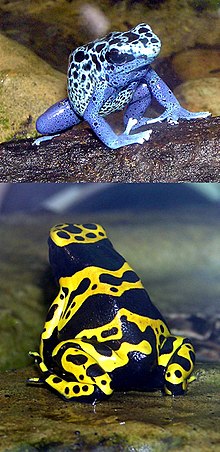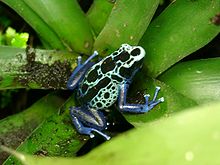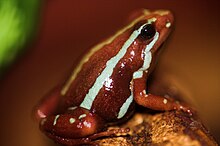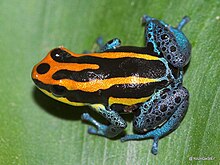| Poison dart frogs (Dendrobatidae) | |||
|---|---|---|---|

| |||
| Dendrobates tinctorius "azureus" (top) and Dendrobates leucomelas (bottom). | |||
| Scientific classification | |||
| Kingdom: | Animalia | ||
| Phylum: | Chordata | ||
| Class: | Amphibia | ||
| Order: | Anura | ||
| Superfamily: | Dendrobatoidea | ||
| Family: | Dendrobatidae Cope, 1865 | ||
| Subfamilies and genera | |||
| |||

| |||
| Distribution of Dendrobatidae (in black) | |||
Poison dart frog (also known as dart-poison frog, poison frog or formerly known as poison arrow frog) is the common name of a group of frogs in the family Dendrobatidae which are native to tropical Central and South America. These species are diurnal and often have brightly colored bodies. This bright coloration is correlated with the toxicity of the species, making them aposematic. Some species of the family Dendrobatidae exhibit extremely bright coloration along with high toxicity, while others have cryptic coloration with minimal to no amount of observed toxicity. The species that have great toxicity derive this from their diet of ants, mites and termites. Other species however, that exhibit cryptic coloration and low to no amounts of toxicity, eat a much larger variety of prey. Many species of this family are threatened due to human infrastructure encroaching on their habitats.
These amphibians are often called "dart frogs" due to the Native Americans' use of their toxic secretions to poison the tips of blowdarts. However, of over 170 species, only four have been documented as being used for this purpose (curare plants are more commonly used), all of which come from the genus Phyllobates, which is characterized by the relatively large size and high levels of toxicity of its members.
Characteristics
Most species of poison dart frogs are small, sometimes less than 1.5 cm (0.59 in) in adult length, although a few grow up to 6 cm (2.4 in) in length. They weigh 1 oz. on average. Most poison dart frogs are brightly colored, displaying aposematic patterns to warn potential predators. Their bright coloration is associated with their toxicity and levels of alkaloids. For example, frogs of the genus Dendrobates have high levels of alkaloids, whereas Colostethus species are cryptically colored and are not toxic.
Poison dart frogs are an example of an aposematic organism. Their bright coloration advertises unpalatability to potential predators. Aposematism is currently thought to have originated at least four times within the poison dart family according to phylogenetic trees, and dendrobatid frogs have since undergone dramatic divergences – both interspecific and intraspecific – in their aposematic coloration. This is surprising given the frequency-dependent nature of this type of defense mechanism.
Adult frogs lay their eggs in moist places, including on leaves, in plants, among exposed roots, and elsewhere. Once the eggs hatch, the adult piggybacks the tadpoles, one at a time, to suitable water, either a pool, or the water gathered in the throat of bromeliads or other plants. The tadpoles remain there until they metamorphose, in some species fed by unfertilized eggs laid at regular intervals by the mother.
Habitat
Poison dart frogs are endemic to humid, tropical environments of Central and South America. These frogs are generally found in tropical rainforests, including in Bolivia, Costa Rica, Brazil, Colombia, Ecuador, Venezuela, Suriname, French Guiana, Peru, Panama, Guyana, Nicaragua, and Hawaii (introduced).
Natural habitats include subtropical and tropical, moist, lowland forests, subtropical or tropical high-altitude shrubland, subtropical or tropical, moist, montanes and rivers, freshwater marshes, intermittent freshwater marshes, lakes and swamps. Other species can be found in seasonally wet or flooded lowland grassland, arable land, pastureland, rural gardens, plantations, moist savanna and heavily degraded former forest. Premontane forests and rocky areas have also been known to hold frogs. Dendrobatids tend to live on or close to the ground, but also in trees as much as 10 m (33 ft) from the ground.
Reproduction
Many species of poison dart frogs are dedicated parents. Many poison dart frogs in the genera Oophaga and Ranitomeya carry their newly hatched tadpoles into the canopy; the tadpoles stick to the mucus on the backs of their parents. Once in the upper reaches of the rainforest trees, the parents deposit their young in the pools of water that accumulate in epiphytic plants, such as bromeliads. The tadpoles feed on invertebrates in their nursery, and their mother will even supplement their diet by depositing eggs into the water. Other poison frogs lay their eggs on the forest floor, hidden beneath the leaf litter. Poison frogs fertilize their eggs externally; the female lays a cluster of eggs and a male fertilizes them afterward, in the same manner as most fish. Poison frogs can often be observed clutching each other, similar to the manner most frogs copulate. However, these demonstrations are actually territorial wrestling matches. Both males and females frequently engage in disputes over territory. A male will fight for the most prominent roosts from which to broadcast his mating call; females fight over desirable nests, and even invade the nests of other females to devour competitor's eggs.
The operational sex ratio in the poison dart frog family is mostly female biased. This leads to a few characteristic behaviors and traits found in organisms with an uneven sex ratio. In general, females have a choice of mate. In turn, males show brighter coloration, are territorial, and are aggressive toward other males. Females select mates based on coloration (mainly dorsal), calling perch location, and territory.
Taxonomy
Dart frogs are the focus of major phylogenetic studies, and undergo taxonomic changes frequently. The family Dendrobatidae currently contains 16 genera, with about 200 species.
| Genus name and authority | Common name | Species |
|---|---|---|
| Adelphobates (Grant, et al., 2006) | 3
| |
| Andinobates (Twomey, Brown, Amézquita & Mejía-Vargas, 2011) | 15
| |
| Ameerega (Bauer, 1986) | 30
| |
| Colostethus (Cope, 1866) | Rocket frogs | 15
|
| Dendrobates (Wagler, 1830) | Poison dart frogs | 5
|
| Ectopoglossus (Grant, Rada, Anganoy-Criollo, Batista, Dias, Jeckel, Machado, and Rueda-Almonacid, 2017) | 7
| |
| Epipedobates (Myers, 1987) | Phantasmal poison frogs | 8
|
| Excidobates (Twomey and Brown, 2008) | 3
| |
| Leucostethus Grant, Rada, Anganoy-Criollo, Batista, Dias, Jeckel, Machado, and Rueda-Almonacid, 2017 | 6
| |
| Hyloxalus (Jiménez de la Espada, 1870) | 60
| |
| Minyobates (Myers, 1987) | 1
| |
| Oophaga (Bauer, 1994) | 12
| |
| Paruwrobates (Bauer, 1994) | 3
| |
| Phyllobates (Duméril and Bibron, 1841) | Golden poison frogs | 5
|
| Ranitomeya (Bauer, 1986) | Thumbnail dart frogs | 16
|
| Silverstoneia (Grant, et al., 2006) | 8
|
Color morphs
Some poison dart frogs species include a number of conspecific color morphs that emerged as recently as 6,000 years ago. Therefore, species such as Dendrobates tinctorius, Oophaga pumilio, and Oophaga granulifera can include color pattern morphs that can be interbred (colors are under polygenic control, while the actual patterns are probably controlled by a single locus). Differing coloration has historically misidentified single species as separate, and there is still controversy among taxonomists over classification.
Variation in predation regimens may have influenced the evolution of polymorphism in Oophaga granulifera, while sexual selection appears to have contributed to differentiation among the Bocas del Toro populations of Oophaga pumilio.
Toxicity and medicine
Many poison dart frogs secrete lipophilic alkaloid toxins such as allopumiliotoxin 267A, batrachotoxin, epibatidine, histrionicotoxin, and pumiliotoxin 251D through their skin. Alkaloids in the skin glands of poison frogs serve as a chemical defense against predation, and they are therefore able to be active alongside potential predators during the day. About 28 structural classes of alkaloids are known in poison frogs. The most toxic of poison dart frog species is Phyllobates terribilis. It is argued that dart frogs do not synthesize their poisons, but sequester the chemicals from arthropod prey items, such as ants, centipedes and mites – the diet-toxicity hypothesis. Because of this, captive-bred animals do not possess significant levels of toxins as they are reared on diets that do not contain the alkaloids sequestered by wild populations. In fact, new studies suggest that the maternal frogs of some species lay unfertilized eggs, which are laced with trace amounts of alkaloids, to feed the tadpoles. This behavior shows that the poisons are introduced from a very young age. Nonetheless, the captive-bred frogs retain the ability to accumulate alkaloids when they are once again provided an alkaloidal diet. Despite the toxins used by some poison dart frogs, some predators have developed the ability to withstand them. One is the snake Erythrolamprus epinephalus, which has developed immunity to the poison.
Chemicals extracted from the skin of Epipedobates tricolor may be shown to have medicinal value. Scientists use this poison to make a painkiller. One such chemical is a painkiller 200 times as potent as morphine, called epibatidine; however, the therapeutic dose is very close to the fatal dose. A derivative ABT-594 developed by Abbott Laboratories, called Tebanicline got as far as Phase II trials in humans, but was dropped from further development due to unacceptable incidence of gastrointestinal side effects. Secretions from dendrobatids are also showing promise as muscle relaxants, heart stimulants and appetite suppressants. The most poisonous of these frogs, the golden poison frog (Phyllobates terribilis), has enough toxin on average to kill ten to twenty men or about ten thousand mice. Most other dendrobatids, while colorful and toxic enough to discourage predation, pose far less risk to humans or other large animals.
Evolution of skin coloration and toxicity
Skin toxicity evolved alongside bright coloration, perhaps preceding it. Toxicity may have relied on a shift in diet to alkaloid-rich arthropods, which likely occurred at least four times among the dendrobatids. Conspicuous coloration in these frogs is further associated with diet specialization, body mass, aerobic capacity, and chemical defense. Either aposematism and aerobic capacity preceded greater resource gathering, making it easier for frogs to go out and gather the ants and mites required for diet specialization, contrary to classical aposematic theory, which assumes that toxicity from diet arises before signaling. Alternatively, diet specialization preceded higher aerobic capacity, and aposematism evolved to allow dendrobatids to gather resources without predation.
Conspicuousness and toxicity may be inversely related, as polymorphic poison dart frogs that are less conspicuous are more toxic than the brightest and most conspicuous species. Energetic costs of producing toxins and bright color pigments lead to potential trade-offs between toxicity and bright coloration, and prey with strong secondary defenses have less to gain from costly signaling. Therefore, prey populations that are more toxic are predicted to manifest less bright signals, opposing the classical view that increased conspicuousness always evolves with increased toxicity.
Prey mobility could also explain the initial development of aposematic signaling. If prey have characteristics that make them more exposed to predators, such as when some dendrobatids shifted from nocturnal to diurnal behavior, then they have more reason to develop aposematism. After the switch, the frogs had greater ecological opportunities, causing dietary specialization to arise. Thus, aposematism is not merely a signaling system, but a way for organisms to gain greater access to resources and increase their reproductive success.
Dietary conservatism (long-term neophobia) in predators could facilitate the evolution of warning coloration, if predators avoid novel morphs for a long enough period of time. Another possibility is genetic drift, the so-called gradual-change hypothesis, which could strengthen weak pre-existing aposematism.
Sexual selection may have played a role in the diversification of skin color and pattern in poison frogs. With female preferences in play, male coloration could evolve rapidly. Sexual selection is influenced by many things. The parental investment may shed some light on the evolution of coloration in relation to female choice. In Oophaga pumilio, the female provides care for the offspring for several weeks whereas the males provides care for a few days, implying a strong female preference. Sexual selection increases phenotypic variation drastically. In populations of O. pumilio that participated in sexual selection, the phenotypic polymorphism was evident. The lack of sexual dimorphism in some dendrobatid populations however suggests that sexual selection is not a valid explanation.
Functional trade-offs are seen in poison frog defense mechanisms relating to toxin resistance. Poison dart frogs containing epibatidine have undergone a 3 amino acid mutation on receptors of the body, allowing the frog to be resistant to its own poison. Epibatidine-producing frogs have evolved poison resistance of body receptors independently three times. This target-site insensitivity to the potent toxin epibatidine on nicotinic acetylcholine receptors provides a toxin resistance while reducing the affinity of acetylcholine binding.
Captive care
All species of poison dart frogs are Neotropical in origin. Wild-caught specimens can maintain toxicity for some time (this can be obtained through a form of bioaccumulation), so appropriate care should be taken when handling them. While scientific study on the lifespan of poison dart frogs is scant, retagging frequencies indicate it can range from one to three years in the wild. However, these frogs typically live for much longer than that in captivity, having been reported to live as long as 25 years. These claims also seem to be questionable, since many of the larger species take a year or more to mature, and Phyllobates species can take more than two years. In captivity, most species thrive where the humidity is kept constant at 80 to 100% and where the temperature is around 72 °F (22 °C) to 80 °F (27 °C) during the day and no lower than 60 °F (16 °C) to 65 °F (18 °C) at night. Some species tolerate lower temperatures better than others.
Conservation status
Many species of poison dart frogs have recently experienced habitat loss, chytrid diseases, and collection for the pet trade. Some are listed as threatened or endangered as a result. Zoos have tried to counteract this disease by treating captive frogs with an antifungal agent that is used to cure athlete's foot in humans.





